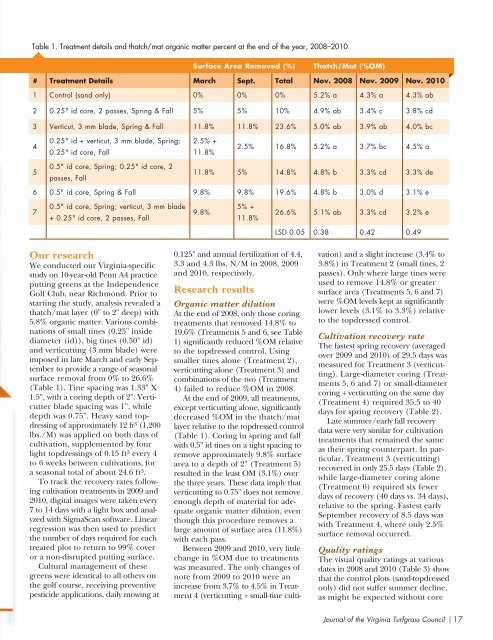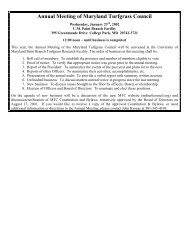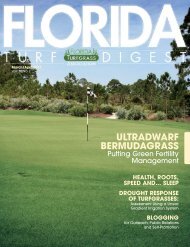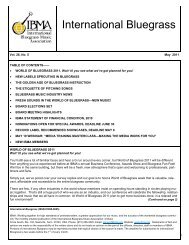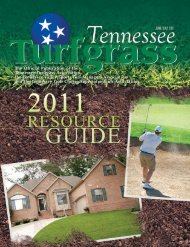Virginia Turfgrass Council / PO Box 5989 / Virginia Beach, VA 23471 ...
Virginia Turfgrass Council / PO Box 5989 / Virginia Beach, VA 23471 ...
Virginia Turfgrass Council / PO Box 5989 / Virginia Beach, VA 23471 ...
- No tags were found...
You also want an ePaper? Increase the reach of your titles
YUMPU automatically turns print PDFs into web optimized ePapers that Google loves.
Table 1. Treatment details and thatch/mat organic matter percent at the end of the year, 2008–2010.Surface Area Removed (%)Thatch/Mat (%OM)# Treatment Details March Sept. Total Nov. 2008 Nov. 2009 Nov. 20101 Control (sand only) 0% 0% 0% 5.2% a 4.3% a 4.3% ab2 0.25" id core, 2 passes, Spring & Fall 5% 5% 10% 4.9% ab 3.4% c 3.8% cd3 Verticut, 3 mm blade, Spring & Fall 11.8% 11.8% 23.6% 5.0% ab 3.9% ab 4.0% bc40.25" id + verticut, 3 mm blade, Spring;0.25" id core, Fall2.5% +11.8%2.5% 16.8% 5.2% a 3.7% bc 4.5% a50.5" id core, Spring; 0.25" id core, 2passes, Fall11.8% 5% 14.8% 4.8% b 3.3% cd 3.3% de6 0.5" id core, Spring & Fall 9.8% 9.8% 19.6% 4.8% b 3.0% d 3.1% e70.5" id core, Spring; verticut, 3 mm blade+ 0.25" id core, 2 passes, Fall9.8%5% +11.8%26.6% 5.1% ab 3.3% cd 3.2% eLSD 0.05 0.38 0.42 0.49Our researchWe conducted our <strong>Virginia</strong>-specificstudy on 10-year-old Penn A4 practiceputting greens at the IndependenceGolf Club, near Richmond. Prior tostarting the study, analysis revealed athatch/mat layer (0" to 2" deep) with5.8% organic matter. Various combinationsof small tines (0.25" insidediameter (id)), big tines (0.50" id)and verticutting (3 mm blade) wereimposed in late March and early Septemberto provide a range of seasonalsurface removal from 0% to 26.6%(Table 1). Tine spacing was 1.33" X1.5", with a coring depth of 2". Verticutterblade spacing was 1", whiledepth was 0.75". Heavy sand topdressingof approximately 12 ft 3 (1,200lbs./M) was applied on both days ofcultivation, supplemented by fourlight topdressings of 0.15 ft 3 every 4to 6 weeks between cultivations, fora seasonal total of about 24.6 ft 3 .To track the recovery rates followingcultivation treatments in 2009 and2010, digital images were taken every7 to 14 days with a light box and analyzedwith SigmaScan software. Linearregression was then used to predictthe number of days required for eachtreated plot to return to 99% coveror a non-disrupted putting surface.Cultural management of thesegreens were identical to all others onthe golf course, receiving preventivepesticide applications, daily mowing at0.125" and annual fertilization of 4.4,3.3 and 4.3 lbs. N/M in 2008, 2009and 2010, respectively.Research resultsOrganic matter dilutionAt the end of 2008, only those coringtreatments that removed 14.8% to19.6% (Treatments 5 and 6, see Table1) significantly reduced %OM relativeto the topdressed control. Usingsmaller tines alone (Treatment 2),verticutting alone (Treatment 3) andcombinations of the two (Treatment4) failed to reduce %OM in 2008.At the end of 2009, all treatments,except verticutting alone, significantlydecreased %OM in the thatch/matlayer relative to the topdressed control(Table 1). Coring in spring and fallwith 0.5" id tines on a tight spacing toremove approximately 9.8% surfacearea to a depth of 2" (Treatment 5)resulted in the least OM (3.1%) overthe three years. These data imply thatverticutting to 0.75" does not removeenough depth of material for adequateorganic matter dilution, eventhough this procedure removes alarge amount of surface area (11.8%)with each pass.Between 2009 and 2010, very littlechange in %OM due to treatmentswas measured. The only changes ofnote from 2009 to 2010 were anincrease from 3.7% to 4.5% in Treatment4 (verticutting + small-tine cultivation)and a slight increase (3.4% to3.8%) in Treatment 2 (small tines, 2passes). Only where large tines wereused to remove 14.8% or greatersurface area (Treatments 5, 6 and 7)were %OM levels kept at significantlylower levels (3.1% to 3.3%) relativeto the topdressed control.Cultivation recovery rateThe fastest spring recovery (averagedover 2009 and 2010) of 29.5 days wasmeasured for Treatment 3 (verticutting).Large-diameter coring (Treatments5, 6 and 7) or small-diametercoring + verticutting on the same day(Treatment 4) required 35.5 to 40days for spring recovery (Table 2).Late summer/early fall recoverydata were very similar for cultivationtreatments that remained the sameas their spring counterpart. In particular,Treatment 3 (verticutting)recovered in only 25.5 days (Table 2),while large-diameter coring alone(Treatment 6) required six fewerdays of recovery (40 days vs. 34 days),relative to the spring. Fastest earlySeptember recovery of 8.5 days waswith Treatment 4, where only 2.5%surface removal occurred.Quality ratingsThe visual quality ratings at variousdates in 2008 and 2010 (Table 3) showthat the control plots (sand-topdressedonly) did not suffer summer decline,as might be expected without coreJournal of the <strong>Virginia</strong> <strong>Turfgrass</strong> <strong>Council</strong> | 17


